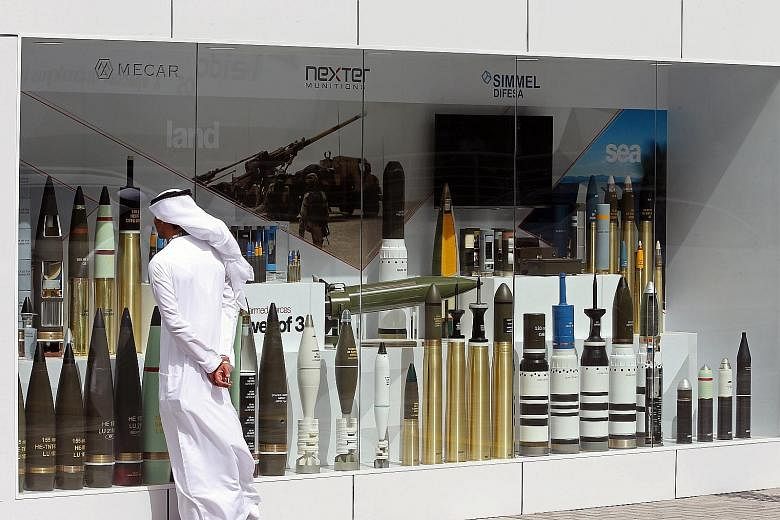STOCKHOLM • The global arms trade has risen to its highest level since the Cold War in the last five years, driven by demand from the Middle East and Asia.
Between 2012 and 2016, countries in Asia and Oceania accounted for 43 per cent of the world's arms imports by volume - a 7.7 per cent rise compared with the previous four-year period, according to a study published yesterday by the Stockholm International Peace Research Institute (Sipri).
The volume of major weapons changing hands was the highest for any five-year period since the end of the Cold War, the independent institute said.
The United States and France are the main weapons providers for the Middle East, while Russia and China are the main exporters to Asia.
Arms imports by countries in South-east Asia increased by 6.2 per cent.
-
Big buyers
-
• India was the world's largest importer of major arms from 2012 to 2016, accounting for 13 per cent of the global total. From the period 2007 to 2011, to the period 2012 to 2016, it increased its arms imports by 43 per cent.
• Saudi Arabia was the world's second largest arms importer in the period 2012 to 2016, with an increase of 212 per cent.
• Qatar raised its arms imports by 245 per cent.
• Algeria was the largest arms importer in Africa with 46 per cent of all imports to the region.
• Nigeria, Sudan and Ethiopia were the largest importers in sub-Saharan Africa .
• The Americas: Total arms imports by states decreased by 18 per cent between the period 2007 to 2011 and the period 2012 to 2016. Colombia's arms imports slid by 19 per cent but Mexico's arms imports grew by 184 per cent.
• Europe: Imports by states decreased by 36 per cent between the two four-year periods. Initial deliveries of advanced combat aircraft started in the period 2012 to 2016 and further deliveries will drive import volumes up in future years.
SOURCE: STOCKHOLM INTERNATIONAL PEACE RESEARCH INSTITUTE (SIPRI)
-
Big sellers
-
• The United States was the top arms exporter in the 2012-2016 period, with a 33 per cent market share (up 3 points) of global arms exports. Its arms exports increased by 21 per cent compared with 2007-2011. Almost half of its arms exports went to the Middle East.
• Russia accounted for a 23 per cent (down 1 point) share of global exports in the 2012-2016 period, with 70 per cent of its arms exports going to four countries: India, Vietnam, China and Algeria.
• China's share of global arms exports rose from 3.8 to 6.2 per cent between 2007-2011 and 2012-2016. It is now a top-tier supplier.
• France passed Germany to take fourth place with 6 per cent (down 0.9 point) of global arms exports. French arms export deliveries may increase soon because of a series of major contracts signed in the past five years.
• German arms exports - counted over a five-year period - decreased by 36 per cent (down 3.8 points) between 2007-2011 and 2012-2016, despite a spike in arms exports last year.
SOURCE: STOCKHOLM INTERNATIONAL PEACE RESEARCH INSTITUTE (SIPRI)
Vietnam made a particularly large jump. It went from being the 29th-largest importer in the period from 2007 to 2011, to the 10th-largest between 2012 and 2016. The volume of its arms imports increased by 202 per cent.
"With no regional arms control instruments in place, states in Asia continue to expand their arsenals," said Dr Siemon Wezeman, senior researcher with Sipri's arms and military expenditure programme.
"While China is increasingly able to substitute arms imports with indigenous products, India remains dependent on weapons technology from many willing suppliers, including Russia, the United States, European states, Israel and South Korea."
The arms imports share of countries in the Middle East, including the Gulf monarchies, jumped from 17 per cent to 29 per cent - far ahead of Europe at 11 per cent, the Americas at 8.6 per cent and Africa at 8.1 per cent.
"Over the past five years, most states in the Middle East have turned primarily to the United States and Europe in their accelerated pursuit of advanced military capabilities," said Dr Wezeman.
He added: "Despite low oil prices, countries in the region continued to order more weapons in 2016, perceiving them as crucial tools for dealing with conflicts and regional tensions."
Sipri said that worldwide arms imports and exports over the last five years have reached a record level since 1950.
Saudi Arabia was the second-largest importer of weapons in the world, with the volume of exports up by 212 per cent.
It came in behind India - which, unlike China, does not produce arms at the national level yet.
The United States remains the world's top weapons exporter, with a 33 per cent market share - ahead of Russia, with 23 per cent, and China, with 6.2 per cent of the trade.
These three countries, along with France and Germany, account for almost 75 per cent of global exports of heavy weapons.
France has overtaken Germany in the export ranking, as a result of contracts signed with Egypt, which has acquired Mistral-style warships and Rafale combat aircraft.
Dr Aude Fleurant, head of the armaments program at Sipri, said that "competition is fierce among European producers", with France, Germany and Britain in the lead.
AGENCE FRANCE-PRESSE

